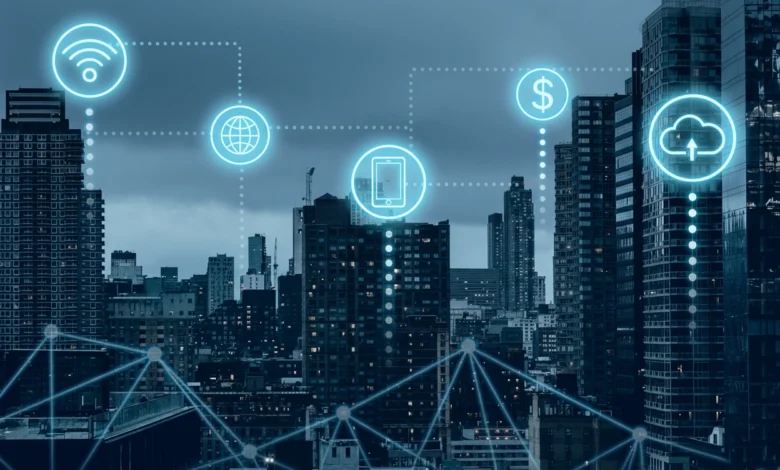
Smart cities use the Industrial Internet of Things (IIoT) to connect infrastructure, mobility, and energy systems through intelligent sensors and data analytics. This integration enables sustainable growth, efficient energy use, and improved quality of life in urban areas.
As the 21st century advances, cities are becoming the focal point of global innovation, sustainability, and digital transformation. The rise of smart cities—urban ecosystems driven by the Industrial Internet of Things (IIoT) is reshaping how we live, move, and manage resources.
Smart cities combine connected infrastructure, data-driven governance, and intelligent energy systems to create efficient, resilient, and citizen-centered environments. This article explores how IIoT technologies power this transformation across infrastructure, energy, mobility, and governance.
1. Intelligent Infrastructure: The Digital Backbone of Smart Cities
Smart infrastructure connects the physical and digital worlds, enabling real-time insights and adaptive urban services.
Key Takeaways
-
IoT sensors collect real-time data across utilities, transportation, and public safety.
-
Edge computing ensures faster local processing, while cloud platforms handle large-scale analytics.
-
Digital twins simulate infrastructure behavior to improve planning and resilience.
-
Open data standards ensure interoperability among diverse urban systems.
Example:
Singapore’s “Virtual Singapore” digital twin allows planners to test scenarios from flood management to new building designs before implementation.
2. Energy Management and Urban Sustainability
Energy efficiency is central to every smart city. IIoT solutions are transforming how power is generated, distributed, and consumed.
Core Concepts
-
Distributed Energy Resources (DERs): Solar rooftops, wind micro-turbines, and batteries form microgrids that reduce dependence on centralized grids.
-
Smart Grids: IoT sensors balance energy supply and demand in real time.
-
Demand Response: Smart meters and connected appliances adjust usage based on pricing or grid conditions.
-
Energy-as-a-Service (EaaS): Enables cities to upgrade to renewables without heavy upfront investments.
Quick Fact:
According to the International Energy Agency (IEA), smart grids could cut global power-related emissions by up to 15% by 2030.
3. Smart Mobility: Redefining Urban Transportation
Mobility remains a critical challenge for urban planners. IIoT-driven systems are making transport cleaner, safer, and more efficient.
Smart Mobility Solutions
-
Mobility-as-a-Service (MaaS): Unified apps integrate buses, trains, bikes, and ride-sharing in one platform.
-
Connected Vehicles: V2X (Vehicle-to-Everything) communication allows adaptive traffic lights and safer intersections.
-
Electrification: Smart EV chargers and vehicle-to-grid (V2G) systems support clean mobility.
-
AI-Driven Traffic Management: Predictive analytics reduce congestion and emissions.
Key Takeaway:
Integrating real-time mobility data across transport modes improves travel efficiency and urban livability.
4. Urban IoT Solutions for Operations and Governance
Smart governance uses IoT to enhance decision-making, improve services, and foster citizen trust.
Applications
-
Public Safety: AI-enabled cameras, sensors, and alert systems improve emergency response.
-
Waste & Water Management: Smart bins and leak-detecting pipelines optimize operations.
-
Smart Buildings: Automated lighting and HVAC reduce costs and energy waste.
-
Citizen Engagement Platforms: Apps let residents report issues, track sustainability progress, and access open data.
Ethical Consideration:
Data governance frameworks like GDPR ensure privacy and accountability in data-driven governance.
5. Implementation Challenges and Governance Models
Despite clear benefits, smart city projects face hurdles that require strategic oversight.
Challenges
-
Cybersecurity: The more devices, the higher the risk. Cities must adopt zero-trust architectures.
-
Interoperability: Avoiding vendor lock-in demands open standards and modular integration.
-
Funding Models: Public-private partnerships (PPPs) and green bonds sustain large-scale projects.
-
Human Capital: Upskilling municipal teams is essential for managing digital ecosystems.
-
Ethics and Inclusion: Ensuring equitable access and transparency in technology use.
Key Takeaway:
Governance models must balance innovation, security, and inclusivity to achieve long-term sustainability.
6. Future Research Directions
The smart city revolution is ongoing, with new research areas emerging at the intersection of AI, IoT, and sustainability.
Emerging Focus Areas
-
Resilient Edge Analytics: Creating reliable, low-latency data systems for mission-critical operations.
-
Interoperable Ontologies: Establishing unified data semantics across urban domains.
-
Predictive Urban Planning: Using AI to forecast climate impacts and population shifts.
-
Privacy-Preserving Technologies: Applying federated learning and encryption to protect citizen data.
- Circular Economy Integration: Embedding IoT in recycling, waste reduction, and energy reuse processes.
Smart cities powered by the Industrial Internet of Things represent a new paradigm of urban life one that combines technology, sustainability, and inclusivity.
By investing in intelligent infrastructure, renewable energy systems, connected mobility, and IoT-enabled governance, cities can become more efficient, resilient, and human-centric. The path forward lies not just in adopting technology, but in designing ecosystems where innovation serves people and the planet alike.
Frequently Asked Questions (FAQ)
Q1: What is the role of IIoT in smart cities?
IIoT connects infrastructure, utilities, and transport systems through intelligent sensors and data analytics, enabling real-time monitoring and efficiency.
Q2: How do smart grids contribute to sustainability?
They balance supply and demand dynamically, reducing energy waste and enabling the integration of renewable sources.
Q3: What are the biggest challenges in implementing smart cities?
Cybersecurity, data privacy, funding, and interoperability remain the key hurdles for global adoption.
Q4: Which technologies will shape the next generation of smart cities?
Edge computing, AI-driven analytics, digital twins, and circular economy IoT systems will define the future urban landscape.


